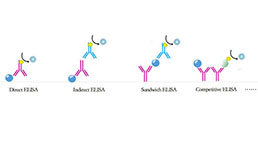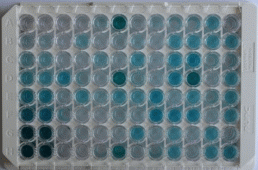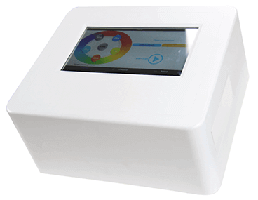Packages (Simulation)

Reagent Preparation

Image (I)
Image (II)
Certificate


ELISA Kit for Prolactin (PRL)
LTH; Luteotropic Hormone
- Product No.SEA846Mu
- Organism SpeciesMus musculus (Mouse) Same name, Different species.
- Sample Typeserum, plasma, tissue homogenates, cell lysates, cell culture supernates and other biological fluids
- Test MethodDouble-antibody Sandwich
- Assay Length3h
- Detection Range0.78-50ng/mL
- SensitivityThe minimum detectable dose of this kit is typically less than 0.30ng/mL.
- DownloadInstruction Manual
- UOM 48T96T 96T*5 96T*10 96T*100
- FOB
US$ 454
US$ 648
US$ 2916
US$ 5508
US$ 45360
For more details, please contact local distributors!
Specificity
This assay has high sensitivity and excellent specificity for detection of Prolactin (PRL).
No significant cross-reactivity or interference between Prolactin (PRL) and analogues was observed.
Recovery
Matrices listed below were spiked with certain level of recombinant Prolactin (PRL) and the recovery rates were calculated by comparing the measured value to the expected amount of Prolactin (PRL) in samples.
| Matrix | Recovery range (%) | Average(%) |
| serum(n=5) | 90-104 | 97 |
| EDTA plasma(n=5) | 78-97 | 90 |
| heparin plasma(n=5) | 93-102 | 97 |
Precision
Intra-assay Precision (Precision within an assay): 3 samples with low, middle and high level Prolactin (PRL) were tested 20 times on one plate, respectively.
Inter-assay Precision (Precision between assays): 3 samples with low, middle and high level Prolactin (PRL) were tested on 3 different plates, 8 replicates in each plate.
CV(%) = SD/meanX100
Intra-Assay: CV<10%
Inter-Assay: CV<12%
Linearity
The linearity of the kit was assayed by testing samples spiked with appropriate concentration of Prolactin (PRL) and their serial dilutions. The results were demonstrated by the percentage of calculated concentration to the expected.
| Sample | 1:2 | 1:4 | 1:8 | 1:16 |
| serum(n=5) | 82-103% | 80-96% | 87-95% | 97-105% |
| EDTA plasma(n=5) | 91-98% | 86-101% | 83-101% | 94-102% |
| heparin plasma(n=5) | 81-95% | 90-98% | 94-105% | 87-95% |
Stability
The stability of kit is determined by the loss rate of activity. The loss rate of this kit is less than 5% within the expiration date under appropriate storage condition.
To minimize extra influence on the performance, operation procedures and lab conditions, especially room temperature, air humidity, incubator temperature should be strictly controlled. It is also strongly suggested that the whole assay is performed by the same operator from the beginning to the end.
Reagents and materials provided
| Reagents | Quantity | Reagents | Quantity |
| Pre-coated, ready to use 96-well strip plate | 1 | Plate sealer for 96 wells | 4 |
| Standard | 2 | Standard Diluent | 1×20mL |
| Detection Reagent A | 1×120µL | Assay Diluent A | 1×12mL |
| Detection Reagent B | 1×120µL | Assay Diluent B | 1×12mL |
| TMB Substrate | 1×9mL | Stop Solution | 1×6mL |
| Wash Buffer (30 × concentrate) | 1×20mL | Instruction manual | 1 |
Assay procedure summary
1. Prepare all reagents, samples and standards;
2. Add 100µL standard or sample to each well. Incubate 1 hours at 37°C;
3. Aspirate and add 100µL prepared Detection Reagent A. Incubate 1 hour at 37°C;
4. Aspirate and wash 3 times;
5. Add 100µL prepared Detection Reagent B. Incubate 30 minutes at 37°C;
6. Aspirate and wash 5 times;
7. Add 90µL Substrate Solution. Incubate 10-20 minutes at 37°C;
8. Add 50µL Stop Solution. Read at 450nm immediately.
GIVEAWAYS
INCREMENT SERVICES
-
 Single-component Reagents of Assay Kit
Single-component Reagents of Assay Kit
-
 Lysis Buffer Specific for ELISA / CLIA
Lysis Buffer Specific for ELISA / CLIA
-
 Quality Control of Kit
Quality Control of Kit
-
 ELISA Kit Customized Service
ELISA Kit Customized Service
-
 Disease Model Customized Service
Disease Model Customized Service
-
 Serums Customized Service
Serums Customized Service
-
 TGFB1 Activation Reagent
TGFB1 Activation Reagent
-
 Real Time PCR Experimental Service
Real Time PCR Experimental Service
-
 Streptavidin
Streptavidin
-
 Fast blue Protein Stain solution
Fast blue Protein Stain solution
-
 Single-component Reagents of FLIA Kit
Single-component Reagents of FLIA Kit
-
 Streptavidin-Agarose Beads
Streptavidin-Agarose Beads
| Magazine | Citations |
| The Journal of Biological Chemistry | In Vivo Evidence for Epidermal Growth Factor Receptor (EGFR)-mediated Release of Prolactin from the Pituitary Gland Jcb: 39297 |
| Journal of Clinical Neuroscience | TLR9 expression is associated with prognosis in patients with glioblastoma multiforme ScienceDirect: S0967586811003572 |
| Sensors and Actuators B: Chemical | Determination of prolactin hormone in serum and urine using an electrochemical immunosensor based on poly(pyrrolepropionic acid)/carbon nanotubes hybrid modified electrodes Sciencedirect:S0925400514000720 |
| Veterinary Word | Effect of extended photoperiod during winter on growth and onset of puberty in Murrah buffalo heifers Pubmed:27051212 |
| Journal of Dairy Science | Effect of thermal stress on physiological, hormonal and haematological parameters in Tharparkar and Karan Fries calves publication:306322503 |
| Stem Cell Research & Therapy | Differentiation of human umbilical cord Wharton’s jelly-derived mesenchymal stem cells into endometrial cells pubmed:29096715 |
| Stem Cell Research & Therapy | The role of mesenchymal stem cells in chemotherapy-induced gonadotoxicity Pubmed:30021657 |
| Frontiers in Molecular Neuroscience | Impact of Triclosan on Female Reproduction through Reducing Thyroid Hormones to Suppress Hypothalamic Kisspeptin Neurons in Mice Pubmed:29403355 |
| Toxicology and Applied Pharmacology | The antipsychotics sulpiride induces fatty liver in rats via phosphorylation of insulin receptor substrate-1 at Serine 307-mediated adipose tissue insulin resistance Pubmed:29551354 |
| Journal of Cellular Biochemistry | The prolactin‐release inhibitor paeoniflorin suppresses proliferation and induces apoptosis in prolactinoma cells via the mitochondria‐dependent pathway Pubmed:29388711 |
| Journal of Cellular and Molecular Medicine | Metformin inhibits growth and prolactin secretion of pituitary prolactinoma cells and xenografts Pubmed: 30334324 |
| BMC Veterinary Research | Hormonal and metabolic indicators before and after farrowing in sows affected with postpartum dysgalactia syndrome Pubmed: 30404636 |
| International Journal of Basic and Clinical Endocrinology | Expression of prolactin receptors in the duodenum, kidneys and skeletal system during physiological and sulpiride-induced hyperprolactinaemia Pubmed: 30143940 |
| MORPHOLOGY AND PATHOMORPHOLOGY | Morphological and Biochemical Characteristics of Prostate Hyperplasia during Sulpiride Treatment Pubmed: 32152847 |
| JOURNAL OF DAIRY SCIENCE | Effect of heat stress during the early and late dry period on mammary gland development of Holstein dairy cattle Pubmed: 32684470 |
| BioMed Research International | Pathophysiological Changes in Female Rats with Estrous Cycle Disorder Induced by Long-Term Heat Stress Pubmed: 32685488 |
| Vet Microbiol | Prolactin affects the disappearance of ALV-J viremia in vivo and inhibits viral infection 34391195 |
| Antioxidants (Basel) | Effects of a Nanoencapsulated Moringa Leaf Ethanolic Extract on the Physiology, Metabolism and Reproductive Performance of Rabbit Does during Summer 34439574 |
| Nutrients | Yogurt Enriched with Inulin Ameliorated Reproductive Functions and Regulated Gut Microbiota in Dehydroepiandrosterone-Induced Polycystic Ovary Syndrome Mice Pubmed:35057459 |
| Catalog No. | Related products for research use of Mus musculus (Mouse) Organism species | Applications (RESEARCH USE ONLY!) |
| RPA846Mu03 | Recombinant Prolactin (PRL) | Positive Control; Immunogen; SDS-PAGE; WB. |
| APA846Mu01 | Active Prolactin (PRL) | Cell culture; Activity Assays. |
| APA846Mu02 | Active Prolactin (PRL) | Cell culture; Activity Assays. |
| APA846Mu03 | Active Prolactin (PRL) | Cell culture; Activity Assays. |
| RPA846Mu01 | Recombinant Prolactin (PRL) | Positive Control; Immunogen; SDS-PAGE; WB. |
| RPA846Mu02 | Recombinant Prolactin (PRL) | Positive Control; Immunogen; SDS-PAGE; WB. |
| EPA846Mu61 | Eukaryotic Prolactin (PRL) | Positive Control; Immunogen; SDS-PAGE; WB. |
| PAA846Mu01 | Polyclonal Antibody to Prolactin (PRL) | IHC |
| PAA846Mu03 | Polyclonal Antibody to Prolactin (PRL) | IHC |
| PAA846Mu02 | Polyclonal Antibody to Prolactin (PRL) | WB; IHC |
| SEA846Mu | ELISA Kit for Prolactin (PRL) | Enzyme-linked immunosorbent assay for Antigen Detection. |
| LMA846Mu | Multiplex Assay Kit for Prolactin (PRL) ,etc. by FLIA (Flow Luminescence Immunoassay) | FLIA Kit for Antigen Detection. |
| KSA846Mu01 | ELISA Kit DIY Materials for Prolactin (PRL) | Main materials for "Do It (ELISA Kit) Yourself". |






